ENA/EDL March in London Again
Tothill St - Duke of York Steps, London. Saturday 31 July 2010
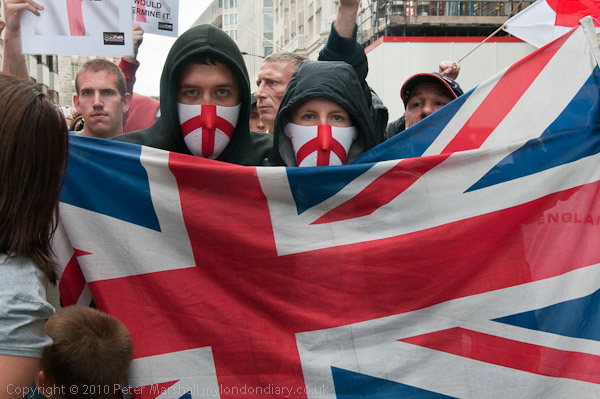
Marchers wearing EDL St George's masks and
carrying the Union Flag
more pictures
The English Nationalist Alliance, mainly the English
Defence League, marched through central London today to deliver a
further letter to Downing St following an unsatisfactory replay to their
May letter. Like the previous 'Patriot March' in May, this London march
was essentially a peaceful one, with marchers chanting and singing as
they walked past Parliament Square and the Cenotaph to Downing St,
before moving on to a rally on the Duke of York Steps. It was organised
by the ENA, a group "founded in May 2010 by Bill Baker, Michael
Johnson and Lynn Corrigan and supported by 800 marchers at the May
Alliance protest in London."
Police had apparently made clear to the organisers that they expected a
disciplined march with and that in particular the marchers should
respect the right of the press to photograph the event. It was a
noticeably smaller march than the 'Patriot March' in May, possibly
because there seemed to have been relatively little publicity in advance
of the event. The organisers claimed 800 marchers at the previous march
in their letter to Mr Cameron; this time there were a little over 150,
including a number of young children with their parents. While still in
Tothill St one of the marchers was warned by police for the using bad
language.
The marchers halted on the road at Downing St and exchanged insults
with a small group of counter-protesters, some with Palestinian flags.
While those against the march largely shouted "Racist Scum",
the retorts from the ENA marchers were more varied; the politer of them
accused the counter-demonstrators of being no longer English. A few
marchers tried to leave the march and go across the road but were
quickly stopped by police, and one was arrested and taken to a police
van.
The counter-demonstrators followed the march as it went up Whitehall
and at one point attempted to climb over the small wall in the pavement
and rush towards the march. Police soon stopped them.
The letter delivered to Downing St pointed out the unsatisfactory reply
they had received from the Ministry of Justice to their previous letter
and complained about the change in the coalition's policy. Before the
elecion David Cameron had promised that the use of Sharia law courts in
mosques was unacceptable to the Conservatives, but ENA claim that since
the election Sharia law has "become further entrenched in our
legislative and judiciary system as a secondary legal system to deal
with the issues of Islamic followers."
They ask that the three issues they stated in the previous letter,
Sharia Law and referendums over EU membership and an English Parliament
should be dealt with and promises made by Conservatives beofre the
election be kept.
The letter was signed by the ENA and ten other groups, the EDL,
Shieldwall, The British Society for Freedom of Speech, Christians for
Democracy, England United (Weiran Ce Angelcynn), England St George,
Acacia Freedom Fighters, Sikhs against Shariah, English Jewish League
and Parents Against Shariah. Another group on the march was March for
England, and along with the St George's flags and Union Jacks there were
also a couple of Israeli flags and a placard from 'One Law for All.'
As on previous events I found some of the shouting and chants
offensive, and in contradiciton of the stated 'Aims and Objectives' of
the ENA, one of which reads: "While no racism or Xenophobia will be
tolerated in our society, no political or social favour will be given to
any ethnic group." I've mentioned on previous occasions my objections to
the slogan 'Muslim bombers off our streets' and also a song about Muslim
Bombers.
There are very few political extremists in the Muslim community in the
UK - one informed source puts the number of supporters of the most
publicised 'Muslims Against Crusades' whose demonstration at a military
parades brought the EDL into being at a total of around 40 people.
Police intelligence suggests that right-wing extremist bombers are
currently more of a threat than Muslims, so perhaps the next march
should chant "Right-wing bombers off our streets" instead. or we could
all agree on "Keep all bombers off our streets" or "Keep the bombers off
our streets."
The march ended at Waterloo Place and where there was a rally. It was
at this point that most of the problems with marchers harassing
photographers occured in May, and there were also some unfortunate
incidents today.
One photographer who is Jewish met with some anti-semitic comments, and
I was pointed out by one of the speakers, Blackburn with Darwen English
Democrats Party councillor Michael Johnson, as an unwelcome guest and
police stepped in as a number of people moved rather menacingly towards
me. A couple of days earlier the ENA web site had published a feature
which - among other things - wrongly accused me of publishing lies about
the previous march, along with my picture and the statement "he must
be confronted and chased away in all future events as a socialist
collaborator who cannot tell the truth."
The material they complained about had been published not by me but by
another journalist, and earlier on the march I'd received a couple of
apologies for the mistake, along with several compliments from other
people taking part who had been there on the previous occasion and read
my report.
One of the things that make Britain great is freedom and in many ways
its something we should be proud of but also have to keep striving to
protect. The freedom to demonstrate is an important part of this, as so
too is freedom of expression, and of course the freedom of the press.
The article on the web site was an attack on that freedom, suggesting
that the ENA should attempt to impose censorship and limit reporting to
those who support it.
Earlier during the event the relationships between the photographers
and the marchers had seemed to be much improved, and I'd hoped that the
ENA was at last coming to realise that journalists in general aim to
report accurately (although often photographers are very unhappy about
how their work is used - or not - by editors.) Members of the NUJ have
varied political views but work under a clear ethical code demanding
fair and accurate recording, and as at the previous march there were
quite a few of us covering the event.
That virtually no coverage appeared in the mainstream press, despite
the story and pictures being available isn't the fault of journalists
but reflects the values and interests of the editors and owners of what
is, in the UK, largely a right-wing press, and certainly can't sensibly
be blamed on 'socialist journalists'. My report of the event on Demotix
- similar to this account - was one of few to appear.
more pictures
Christians Protest Pakistan Persecution
Pakistan High Commission & Whitehall, London. Sat 31 July 2010
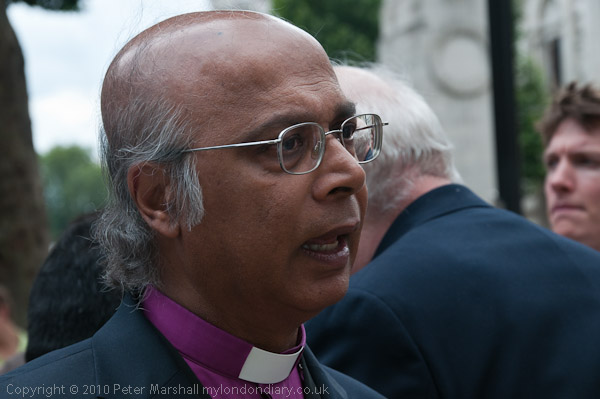
Former Bishop of Rochester, Michael Nazir Ali, was
the main speaker at Downing St
more pictures
The British Pakistani Christian Association and other Christians held a
rally outside the Pakistan High Commission, delivering a letter calling
for the end of persecution there, before marching to a rally at Downing
St.
There were just over 50 people at the High Commission on Saturday
morning, representing a number of Christian groups, and the proceedings
started with a short address by a Christian Party candidate, followed by
prayers, short addresses and singing led by several pastors. The main
address came from Bishop Mike Reid of 'Can do Ministries' and then a
deputation presented a petition to the Pakistan High Commission, while
the worship and speeches continued.
The deputation was received politely by two men at the High Commission.
But although the Pakistani government expresses its support for the
rights of minorities, many feel that it does little if anything in
practice to protect these rights.
Blasphemy laws are being used in Pakistan to persecute minority
religious groups, including Christians. But it is not only the laws, but
also the attitudes that lie behind them and are encouraged by them. One
story that was told was of two pastors who had been charged under these
laws and taken to court. There the evidence - including that from the
police and authorities - proved them innocent and they were acquitted.
As they left court they were shot and killed. No one has been arrested
or charged over the shooting.
On 25 March 2010 the United Nations Human Rights Council adopted a
resolution proposed by Pakistan on behalf of the Organisation of Islamic
Conference, "combating defamation of religions." The UK government was
one of those that voted against the resolution which was carried 20 to
17 with 8 abstentions and 2 absent and many governments and
organisations had argued that the resolution is - in the words of a
statement from the International Freedom of Expression Exchange (IFEX)
network, "fundamentally incompatible with the human right to freedom of
expression, as protected by Article 19 of the International Covenant on
Civil and Political Rights (ICCPR). It is also incompatible with Article
20 of the ICCPR, which only prohibits advocacy of national, racial or
religious hatred that constitutes incitement to violence, discrimination
and hatred."
Or, as one of the speakers put it more succintly, we need human rights
to protect people, not systems of belief.
From Knightsbridge the protesters marched to Downing Street, going post
Piccadilly Circus and Trafalgar Square, carrying a large and very heavy
wooden cross and stopping at three strategic points for prayers,
including the Lords Prayer. Opposite Downing Street where roughly the
same number of people were waiting to greet the marchers there was some
fine singing from Diana Orfuri or the Christina Party and Holy Nation
Church and an address by former Bishop of Rochester, Michael Nazir Ali,
who then went with a small group to deliver the petition to Downing St.
I didn't go with them, but returned to the rally which continued with a
number of speeches, including Sikhs and Hindus supporting the campaign,
but these had to be strictly limited in time as the event had to finish
at 2pm. Fortunately there was enough time for me to eat one of the
excellent samosas that were handed round.
more pictures
Tomlinson Decision Protest
DPP's Office and Cornhill, London. Friday 30 July 2010
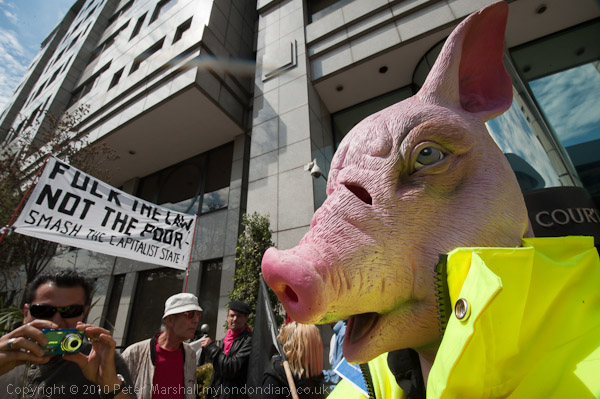
Anti-capitalist protestors outside the DPP's
offices in Rose Court, Southwark Bridge Road
more pictures
Around two hundred people, including many of London's best-known
anti-capitalists and anarchists, rallied outside the Director of Public
Prosecution's office in protest at the shameful decision not to
prosecute any police over the killing of Ian Tomlinson. After silence
and speeches they marched to where he died in the City. London, UK.
The crowd gathered with banners outside the offices on Southwark Bridge
Road, spilling over from the pavement into the road. Present were many
of those who actively campaign for freedom, human rights and justice in
the capital.
Among those who spoke were Professor Chris Knight, who talked of his
first approach to Paul King, one of Ian Tomlinson's sons, shortly after
the death of his father. Knight felt some personal responsibility as one
of the organisers of the G20 event at the Bank of England at which
Tomlinson, an innocent bystander walking home from work, was struck by
PC Simon Harwood and, shortly after, died. Although at first King didn't
want to talk to him, soon the family and the protesters were organising
together in a campaign to get justice over the death, caused not by any
action of the protesters but the result of a deliberately combative
attitude by the police. Faced with a demonstration intended by its
organisers to have a carnival atmosphere, the police went onto TV and
radio, working up the tension and greatly exagerating the possibilities
of civil disorder (a couple of days before some members of the police
had even bought
catapults and tried to plant them at a demonstration), with a
paramilitary (or gangster) style response typified by the statement made
by Commander Simon O'Brien of the Met, "We're up for it".
The police response after the incidents - and particularly over the
death of Tomlinson has shown a shocking disregard for the victim, with
deliberate lies and attempts to pervert justice. At the time police
impeded the efforts of people to give Tomlinson medical assistance and
were slow to get an ambulance to the spot. Unbelievably they were unable
to produce any CCTV evidence of the incident. They made sure that the
first post-mortem by Dr Freddy Patel gave an incorrect and misleading
result. In questioning people about what happened they - and the IPCC -
showed far more interest in trying to get evidence against demonstrators
- who seem to have reacted compassionately towards the injured man -
than about the activities of the police who were intent on continuing
their attacks against the crowds.
The truth only came clearly to light because another bystander watching
the events had filmed the support on his mobile phone and a few days
later, realising the importance of this evidence had supplied it to The
Guardian.
What we have seen since then is a remarkably slow process involving the
police, Crown Prosecution Service and the so-called Independent Police
Complaints Commission, each going beyond the call of duty to ensure that
justice would not be done. Enquiries that should have taken days or at
most weeks have been dragged out to well over a year, presumably in the
hope that the outcry when justice was clearly seen not to be done would
be less with the passage of time.
They kept the inquiry going so that once they had decided - for
transparently spurious reasons - not to proceed with a murder charge it
was too late to prosecute PC Simon Harwood (an officer who had
previously been investigated for alleged aggressive behaviour) for any
lesser charge. He faces a disciplinary hearing which will be held in
private.
As speakers at the rally pointed out, although since 1969 over a
thousand people have died in police custody in the UK, not one single
police officer has been charged with either manslaughter or murder in
even a single case. Where this case differs from most is that Tomlinson
was white rather than black and that it happened in public view rather
than behind closed doors, and that there seems to be very clear evidence
of a crime.
Harwood had removed his badge and was wearing a balaclava to avoid
identification. In the video he comes up behind Tomlinson and without
any provocation hits him with his baton, and shoves him to the ground.
Tomlinson manages to get up, staggers a few yards around the corner and
then collapses and is dead when the ambulance arrives. If Harwood had
not been a police officer it would surely have been an open and shut
case.
Although DPP Kier Starmer was apparently unable to distinguish between
the evidence of a pathologist facing a disciplinary hearing for
incompetence by the General Medical Council involving 26 cases and
already found by the Home Office to have failed to detect clear evidence
of injuries in three other cases and that of two other pathologists in
agreement about the cause of death, it is inconceivable that any sane
jury would have shared his difficulty in reaching a conclusion.
As several speakers pointed out, the police rely on the cooperation and
confidence of the public to carry out their job, and by behaving as if
they are above the law they risk losing these. Several suggested that
the people needed to take the law into their own hands as the police
could no longer be trusted to uphold it.
The most moving contribution came from Samantha Rigg-David, whose
brother Sean Rigg died 90 minutes after being taken in to Brixton police
station in August 2008. Almost two years later his family are still
waiting for the result of the inquest.
At the end of the rally outside the offices of the director of public
prosecutions on the south side of Southwark Bridge, the protesters
formed up on the roadway and marched across the bridge, turning into
Cannon St and then up King William Street to Bank, with police stopping
the traffic to allow them to proceed.
They paused briefly on the Bank junction at the centre of the City,
with one or two sitting down on the roadway before moving down Cornhill
to where Ian Tomlinson spent his final moments. A small bunch of
withered flowers tied to a post marked the spot. The marchers halted and
after a short final address by Chris Knight held a final minute of
silence which was also respected by city workers making their way along
the street.
more pictures
Vedanta AGM Protest
Great George Street, Westminster, London. Wed 28 July 2010
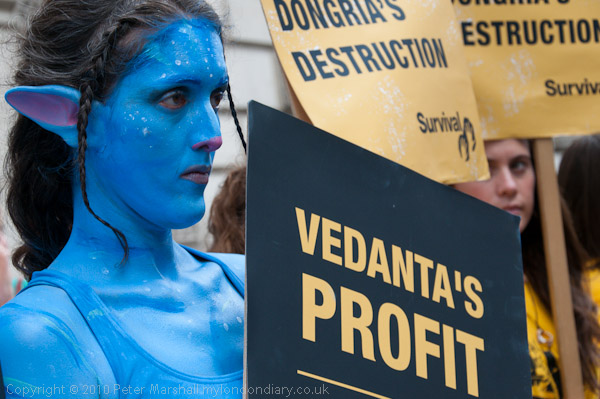
Bright blue Avatar aliens protest against Vendanta destroying the
Dongria in Orissa
more pictures
Human rights activists outside the AGM of Vedanta, owned by billionaire
Anil Agarwal, demanded an end of the company's killings, displacement
and wiping out of an ancient civilisation in the Niyamgiri Hills of
India by bauxite mining.
Among the demonstrators were actors from the James Cameron film
'Avatar' and there were two bright blue aliens from the tribe destroyed
in in that film. Vedanta has already built an aluminium refinery in
Lanjigarh amd has carried out preliminary work for bauxite mining in
Orissa's Niyamgiri Hills which will destroy the ancient civilisation of
the Dongria Kondh adivasi community for whom these mountains and forests
are Gods.
Already in Orissa, according to campaigning group Foil Vedanta, Vedanta
have caused more than 100 deaths though accidents, police fire, forced
displacement, injury and illness. More than a thousand people have
already been displaced, with 8000 under threat, moved away from their
traditional sources of income and dumped into shanty towns where there
is no work. Thousands of acres of fertile agricultural land have been
destroyed, rivers and streams disrupted and drinking water contaminated
by fly ash and toxic red mud.
Foil Vedanta have a simple answer to why this is happening:
"Mega-profits for billionaires with blood on their hands." Various
shareholders have been convinced by the arguments and have pulled out -
the Church of England sold its £3.8m holding on February 5 this year,
and the Joseph Rowntree Trust its £1.9 million, "due to serious concerns
about its approach to human rights and the environment, particularly in
the Indian state of Orissa." Earlier this month Action Aid reported that
the Dutch pensions company PGGM had pulled out almost &11 million
because of the "financial risk in investing a company that was
‘persistently ignoring’ environmental and human rights."
Supporters of the campaign against Vedanta include Amnesty
International, Survival International and Action Aid, for whom Bianca
Jagger attended the AGM to "take a message from India’s threatened Kondh
people direct to shareholders." Some of the other campaigners had also
become shareholders and were able to enter the building; they and the
other shareholders had to duck under the Foil Vedanta banner to reach
the door.
Action Aid point to a damning report on Vedanta by the investment
consultants PIRC which recommends the AGM to oppose the "re-election of
3 non-executive directors on health, safety and environmental grounds."
Vedanta was launched on the London Stock Exchange in 2003 with the help
of the British Government's Department of Trade and Industry and the
Department for International Development (DfID), and although the
government has criticized its lack of a human rights policy, they have
continued to actively support it's mining activities through the DfID
Building Partnerships for Development programme and the Orissa 'Drivers
for Change' research project.
The company's directors have included many powerful figures including
Indian ministers and former ambassadors and David Gore-Booth, former
British Ambassador to Saudi Arabia and High Commissioner of India.
Vendanta and its billionaire CEO Anil Agarwal are said to have close
links with the extremist umbrella group for Indian Hindu right-wing
organistions, Sangh Parivar, said to be responsible for many attacks on
Muslim and Christian communities in Orissa, Gujurat and other parts of
India.
The protest outside the AGM at The Institute of Civil Engineers in
Great George Street, a few yards from Parliament Square, was organised
by Foil Vedanta, and as well as the charities above was supported by
South Asia Solidarity Group, South Asian Alliance, Brent Refugee and
Migrant Forum and London Development Education Centre.
more pictures
Windsor Walk
Windsor and Dorney, Monday 26 July
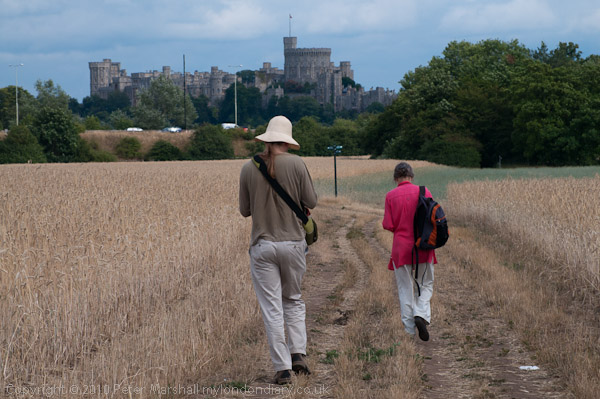
Walking through fields towards the castle
more pictures
I hadn't actually planned this walk - we were supposed to be going out
with some others who had to call off at the last minute. But we ended up
walking around another of the London 2012 Olympic sites, Dorney Lake,
the Eton College rowing lake at Boveney, just to the west of Windsor on
the opposite bank of the Thames.
I don't know why this site was chosen in preference to using the old
Royal Docks in Newham where the Albert Dock was developed as a 2000
metre Olympic standard rowing course with seven lanes and a return lane
and opened in 1999. But certainly Eton sounds rather posher (and
doubtless the college will benefit greatly from the use.)
I didn't take many pictures of the actual lake, largely because I found
it rather boring but it is a very large area opened by the college as a
country park for public use. Unlike the Stratford site there are no tall
electrified fences and security guards, but low fences with frequent
gaps. Our ten mile or so walk took us around it usually a short distance
away but on more interesting paths.
more pictures
Day of Protest against Stoning
Trafalgar Square, London. Saturday 24 July 2010
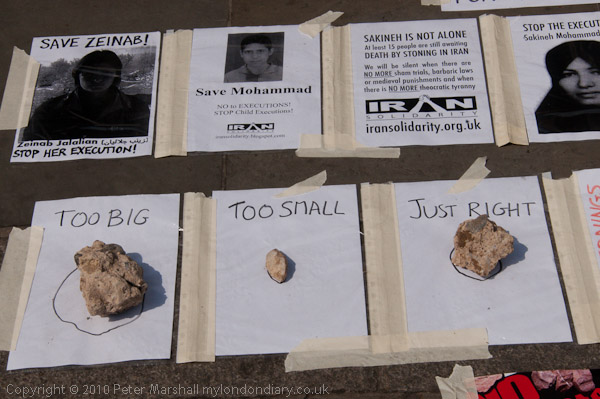
'Islamic Regime = Terror Regime'
more pictures
Protests took place in London, including one in Trafalgar Square, as a
part of an international day of protest against the sentence of
execution passed on Iranian woman Sakine Mahamadi Ashtiani, falsely
accused of adultery.
The International Committee Against Stoning held events in many cities
around the world including Frankfurt, Oslo, Amsterdam, Bremen,
Gothenburg, Malmo, Toronto, Berlin, Tbilisi, Sydney, Ottawa, Venice,
Paris, Berlin, Stockholm and London today to publicise this case that
has shocked the world. In England there were protests in Birmingham,
Chichester, Egham and Richmond as well as London
Public pressure has already led to Iranian authorities to put the
stoning of Sakine Mahamadi Ashtiani at least on hold, and it now seems
more likely that they intend to carry out the death sentence by hanging,
still there a slow strangulation by the noose.
She was sentenced by a Shariah court on the basis of a 'confession'
extracted under duress and which she has since retracted, and her son
and daughter have led a campaign against the sentence, making appeals
for international action to persuade the Iranian authorities to commute
her sentence. She has already been held in prison for five years and
punished with 99 lashes.
Stoning is carried out by burying the victim up to her shoulders and
hurling stones at her. Public repulsion for such a barbaric practice
means that stoning is no longer carried out in public but inside a
prison with the stones thrown by prison guards. The law clearly
specifies that the stones should be large enough to inflict damage and
pain, but not so large as to kill her instantly so that the stoning may
continue for perhaps 30 minutes until death occurs.
Disgusting and barbaric as the sentence on Sakine Mahamadi Ashtiani is,
she is by no means an isolated case. Perhaps even more reprehensible is
that of Azar Bagheri, forcibly married at 14 and charged with adultery
and sentenced to stoning within a year of her marriage. At 15 she was
too young under the law for the sentence to be carried out and she is
still imprison, waiting for her stoning when she is 18. Already they
have taken her out into the yard and carried out two mock stonings,
burying her up to the neck but stopping before throwing the stones.
German human rights activist Mina Ahadi who has reported her case has
also had phone calls from the family of a third woman in the same Tabriz
prison under sentence of stoning, Marian Ghorbanzadeh, age 25.
According to The Guardian, Ahadi says the she knows of 12 other women
sentenced to death by stoning currently held in Iranian prisons and
estimates that there are some 40 or 50 others.
A steady stream of people came to look at the demonstration on the
north terrace of Trafalgar Square, and some joined in and stood holding
placards for a few minutes along with the protesters, including a small
group wearing coloured full body (Zentai) suits. I had to wait for a few
minutes in a queue to sign the petition against stoning.
Several people, including Maryam Namazie spoke at the event, calling
for an end to these barbaric punishments and to the outdated law behind
them.
more pictures
Parliament Square Protests Continue
Parliament Sq. & Victoria Tower Gdns, London. Sat 24 July 2010
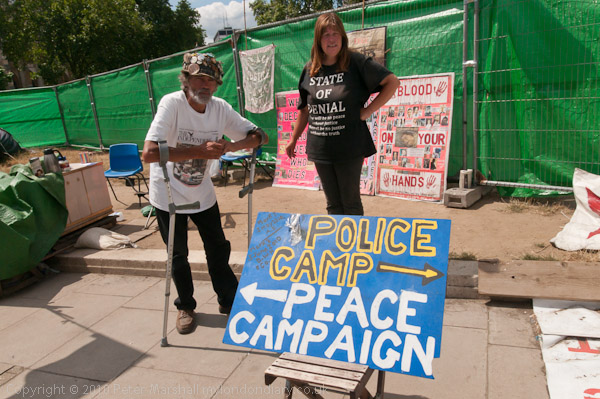
Brian Haw and Barbara Tucker with a new fence to
display posters on
more pictures
Since the
Democracy Village was evicted from the square in the
early hours of last Tuesday and most of the grassed area of the square
fenced off there has been considerable speculation about the future of
demonstrations in the square.
Many of us worried that the eviction would be an occasion for further
harassment of the Parliament Square Peace Campaign, but in the
event Brian Haw and Barbara Tucker received a visit by police and the
Greater London Authority representative as the eviction started and were
reassured that they would not be affected. The fence has been carefully
routed a little way back around their area - and has created a further
opportunity for their display. The decision on the eviction of the
Democracy Village the previous Friday did not directly effect them, and
restated their legal right to remain on the pavement while remitting
their occupation of a small area of the green for a couple of tents to a
High Court hearing.
The two other currently permanent protests along the edge of the
pavement, Maria Gallastegui's Peace Strike and the hunger
strike by Len Miskulin, now on his 29th day, were also left in
place. Len has campaigned for years for the rights of fathers and
children, and has built up a dossier on illegal seizure of assets which
he feels shows that the judicial system is totally corrupt and used by
the state to deny our basic human rights. He has been denied contact to
his two children for ten years and is the subject of a gagging order
that means he cannot talk to the press about what has happened to him.
So I had to look on the web to find out more about him.
The Democracy Village had called a meeting on Saturday afternoon in
Victoria Tower Gardens, next to the Thames and immediately south of the
Houses of Parliament. Around 30 people turned up, including most of the
more active members from the camp, and sat around in a large circle. The
start of the meeting was delayed while one of them went to collect the
small oak tree that had formed the centre-piece of the peace garden in
the square and it was placed in the centre of the circle.
Before the meeting officially started, Chris Coverdale
(founder of Make Wars History and co-founder with Maria Gallastegui of
the Peace Strike which suported the Democracy Village) stood up and
informed all present that he had applied for and been granted permission
by the Metropolitan Police for a continuing demonstration on either of
the two pavements of the square for a year, but there were significant
conditions attached.
Police would be entitled to close the demonstration down if it created
serious public disorder or serious damage to property and it "must
not disrupt the life of the community" or risk the safety of
members of the public.
The news clearly received a very mixed welcome from those present and
was presented before the meeting so it could be discussed, although one
or two did not feel this was appropriate.
The Parliament Square Peace Campaign were restricted to a 3
metre wide display by a court decision some years ago, and that appears
to have become some kind of standard. The authorisation obtained by
Coverdale covers an area of 3m x 3m and a height of 1.5 meters for any
structures and would allow up to 20 people at any one time to protest
within that area - and they could also hold banners and placards which
could of course be taller. Maria Gallastegui already has a number of
separate authorisations for four permanent displays and several ongoing
24-hour vigils on the square.
The authorities appear to have conceded that the square will continue
to be used for protests - both small permanent protests and larger
short-term events. One of the Mayor and the court's justifications for
clearing the Democracy Camp was indeed that its presence was restricting
the rights of others to protest in the area.
The meeting opened with those present standing and linking hands to
sing Leon Rosselson's 'The World Turned Upside Down' (as sung
by Billy Bragg) about the Diggers who in 1649 occupied and cultivated St
George's Hill in Weybridge. They were eventually forced to move out
following gang attacks on them organised by the land owners and a court
case in which they were not allowed to present their defence (it
happened to Barbara Tucker in the recent case too.)
The discussion then began, and I had to leave to go elsewhere. Several
hours later a number of those present made a number of token protests in
Parliament Square, going inside the fence and being removed by police
and bailiffs, some several times, flouting the court injunction. One
man, sitting on the grass with a Peace flag, was arrested and told he
would be charged with a breach of the peace, but I was told he was later
released without charge. Apparently eventually the police lost interest
and went away leaving a couple of young women sitting on the grass. So
although some of the Democracy Village may take part in the authorised
protest, others seem likely to continue with simiilar unauthorised
activities in Parliament Square, and a further meeting has been called
for next Saturday.
more pictures
No Breakfast at NPG
National Portrait Gallery, London. Tuesday 20 July 2010
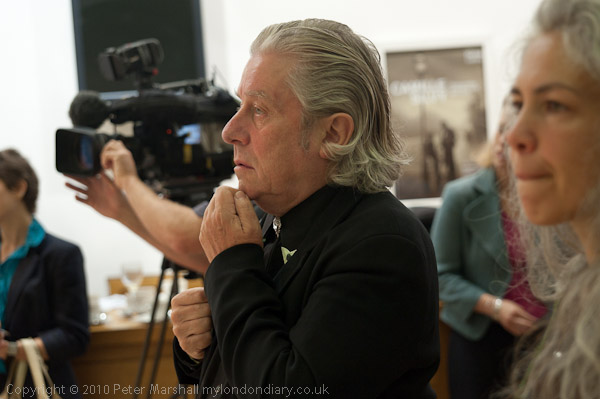
Brian Griffin listens as rower Katherine Grainger talks about being
photographed by Bettina von Zwehl.
more pictures
I can't understand why the National Portrait Gallery called
the event a breakfast launch as there was no breakfast on offer as they
opened the latest phase of their Olympic project on Tuesday morning -
the free show runs until 26 September 2010. As well as more pictures by
Brian Griffin, there is also a set of images by Bettina
von Zwehl.
Later I was able to photograph Katherine Grainger standing
beside the portrait of her by von Zwehl (all photographs in this review
are © Peter Marshall 2010, but included works by the photographers in
the show are © Bettina von Zwehl - National Portrait Gallery/BT Road to
2012 Project or © Brian Griffin - National Portrait Gallery/BT Road to
2012 Project respectively.) It and the similar pairing of young
weightlifter Zoe Smith I think typify the problem I have with these
portraits.
Somehow to me they all look too much the same. And where I met the
sitter they didn't look very much like the real people who were used to
make them for those who were present. Of course portraits aren't just
about a physical resemblance (though I think its a necessary starting
point), but these all seem to me to have a particular look regardless of
the personality. It's a look which I think best suits sullen adolescents
and those I met were clearly not that. Grainger's portrait was
apparently meant to portray her as something of a Greek goddess but I
could see nothing of that, and she certainly seemed ill at ease in the
black dress that she had been persuaded to wear for the portrait. All of
von Zwehl's images seemed to show me more about the photographer than
the sitter, which isn't what I want from a portrait.
I've long been a fan of Brian Griffin's portraits, and there were
several here that showed him still to be at the height of his powers,
though just a few which I felt didn't quite come off, or where he seemed
to be copying or even parodying some of his earlier work. But it's
certainly a set of images worth seeing if you have any interest in
photographic portraiture. You can read a longer piece about his work in
particular and the show in general on >Re:PHOTO
and I won't repeat it all here. But as I end with saying there, it may
well be the best thing that comes out of the Olympics.
more pictures
Swan Upping
Chertsey, Surrey to Windsor, Berks. Monday 19 July 2010
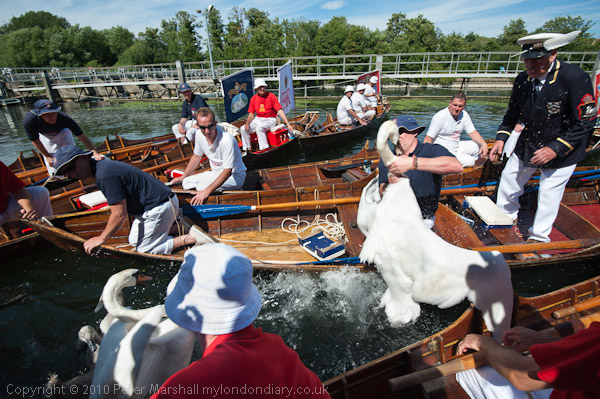
Uppers grapple with swans at Runnymede
more pictures
The annual census of swans and cygnets on the River Thames which began
in the 12th century started today, when the Swan Uppers covered the
river from Sunbury to Windsor.
The swans on the River Thames are shared between the Queen and two
London guilds, the Dyers and the Vintners. Although swans are no longer
eaten, the Queen’s Swan Marker David Barber still makes a count of the
number of cygnets on the river each year. It is probably the longest
continuing environmental survey in the world, and its detailed records
in the 20th century were important in getting legislation to ban the use
of lead weights by anglers.
A small flotilla of boats crewed by skilled waterman, all of whom have
been winners of the annual Doggett's Coat and Badge race for watermen,
makes its way upriver from Sunbury taking five days to cover the Thames
as far as Abingdon. There are two boats crewed by the Queen's men, and
two each from the Dyers and Vintners guild. As as well as the Queen's
Swan Marker, each guild has its own marker.
In the past swans were marked by notches on the beak to show which were
owned by the guilds, but now all swans are ringed and the ownership
recorded in the record books. One of the livery companies (who were
granted the privilege of owning swans a few hundred years after upping
began) still has its records dating back around 500 years, but those of
the other were destroyed in the Great Fire of London in 1666.
The Queen's men wear red, the Dyers are in blue and the Vintners in
white (woad and white wine help me to remember which is which) and the
boats with their swan flags make a colourful spectacle as they go up the
river. Several motor cruisers also flying flags with swans on them come
along behind them, and at times give the rowers a rest by towing the
boats.
Leading the flotilla, sometimes quite a distance ahead is a rather more
ordinary boat with an outboard motor containing the Queen’s Swan Warden,
Professor Christopher Perrins of the University of Oxford and his
assistants, who spot the swans with cygnets and occasionally also look
at other swans to check their rings.
Once a swan with cygnets is found, the uppers quietly and carefully
surround them with their boats, gradually closing in until there is no
open water for them to escape, as swans need a very long clear run to
actually take off. They draw closer and closer until the swans are
trapped in a small area of water and men can then reach in and grab the
adult birds by the necks and pull them from the water.
The adult swans struggle fairly powerfully, but as soon as the uppers
manage to get their legs behind their back they give up and lie still.
Once the adults have been caught the cygnets are also grabbed and taken
aboard. The uppers carry string on their belts to tie the legs together,
and then carry the birds to the bank where they are lined up for
inspection. All the birds get a quick health check, looking for any
injuries or fishing hooks or line, and the cygnets are weighed and their
head length measured. The cygnets and any un-ringed adult birds then
have a ring with an identifying number fixed around one leg, and they
are allocated either to the Queen or to one of the guilds and their
details recorded in the appropriate book.
After this the birds are carefully untied and returned to the water
together, and a few seconds later are swimming again as a family as if
nothing had happened.
Apparently the swan uppers start their journey at Sunbury with a loyal
toast and they also make one in the lock at Windsor, putting on their
ceremonial jackets and standing up in their boats to drink the health of
the Queen in whisky and water. The lock keeper also gets given a glass
and joins in.
A couple of hundred yards upstream from the lock the Dyers and Vinters
boats pull to the sides of the river and the men stand with oars raised
in salute to cheer the Queen's uppers as they pass between them,
standing with oars raised in their boats to return the gesture.
more pictures
Big Lunch Street Party
Wrayfield Road, North Cheam, London. Sunday 18 July 2010
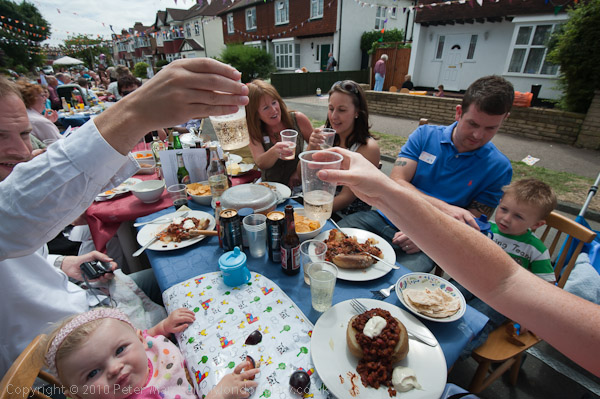
A toast at the street lunch party
more pictures
Street parties for the 2010 'The Big Lunch' were held around
the country on Sunday, part of a nationwide community building project
promoted by the Eden project.
One was in Wrayfield Road, a suburban street in North Cheam, typical of
the 1930s developments around the edges of London, then in Surrey but
now a part of the London Borough of Sutton. The wide tree-lined street
is lined with solidly built semi-detached houses, well designed and
built to include garages for prosperous middle-class families of the
time. Built by Warner and Watson Ltd, the street was completed in 1933/4
although there are a few later additions.
One of the first residents who moved in to those new semis in 1933
still lives there and was at Sunday's party, along with several who
could recall their last street party held for the Queen's Silver Jubilee
in 1977 - and on the top of one garden wall were a set of colour photos
from it.
There was great interest in a framed copy of the original newspaper
advertisement for the houses being shown around, in which they were
advertised for sale at prices that now seem laughable. The 3 bed houses
started at £775 for a house with rear entrance, and for £875 you also
got a garage, coal store and a second WC. Some evern came with a
'tradesmen's entrance' and for £1,095 you got four bedrooms and a
garage. All had a fitted kitchenette, a separate hot water boiler, store
cupboards, a fitted washing machine and other fittings and your choice
of decoration, and they were yours for a deposit of £45 with the balance
to be paid off at 24/7d (£1.23) a week. Of course at the time the
average wage for those in work was around £190 compared with £30,000 now
(though most photographers earn much less!) but even allowing for this
they still appear a bargain; allowing for the increase in wages, that
£1.23 now would be a little under £200 a month.
As well as the lunch, eaten at tables along the middle of the closed
street, there were games for the kids and adults, including a tug of war
and a highly contested ladies egg and spoon, as well as music from a
young DJ, a very professional young woman singer and as I was leaving, a
three man group.
This was a private and relaxed street event, with almost everyone
present living in the street (and a few of their relatives) and almost
everyone on the street joined in, except for a few who were on holiday
or away on business, and everyone certainly seemed to be having a good
time. I was there as one of two invited 'official' photographers, and
there were notices on the street reminding people that by taking part
they had agreed to be photographed, and we were made very welcome.
Particularly for those who organised the event but for everyone who
took part it made them get to know the other people on the street very
much more, no longer just faces seen in passing. And that is very much
the idea behind 'the big lunch',
to build friendships and understanding between people across the
generations and backgrounds. The project web site points the increasing
number of single person households and class and ethnic ghettos and the
continuing drop in trust between neighbours - social trust in the UK is
now among the lowest in Europe. Events like this help to counter these
trends and to cut down the social problems that arise from increasing
isolation - crime, domestic violence, homelessness and child poverty.
Several local businesses supported the event and the London Fire
Service fire engine made a couple of brief visits, although they
couldn't stay for long as there services were in demand - as well as
emergency calls there were also two other street parties in the borough.
Another visitor was the local MP Paul Burstow, named by the Evening
Standard in 2005 as London's hardest working MP.
more pictures
Bring Troops Home Demo Halts Traffic
Whitehall, London. Friday 16 Jul 2010
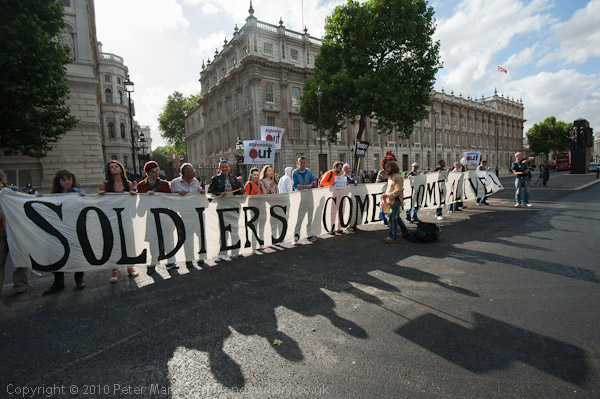
Demonstrators from the Democracy Village in front of Downing St
more pictures
Following the killing of 4 UK soldiers in one day i n Afghanistan, Stop
the War called a demonstration opposite Downing St on Friday.
They were joined by the Democracy Village who staged a sit
down on Whitehall.
Earlier in the day the Democracy campers had lost their court case to
stay in Parliament Square. They were refused leave to appeal to the UK
supreme court, although the case may well go to the European Court,
where they would appear to have a very good chance of success. In the
meantime the court order that they must leave the square is likely to be
enforced, most probably in the early hours of Monday morning. [It
actually happened a day later, early on Tuesday.]
Although the court decision should not affect Brian Haw and his
Parliament Square Peace Campaign, there since June 2001, it seems quite
likely that police will use the occasion to further harass Mr Haw and
his fellow demonstrators, as happened recently on the occasion of the
State Opening of Parliament. His case to remain in the square is likely
to come to court again before too long, and if the authorities can chose
the same judge he would be very unlikely to win.
Opinion polls show that only a small minority - less than one fifth in
one recent poll - of the UK public now support the continuing engagement
of UK forces in Afghanistan. Earlier in the week the news that three had
been killed by one of the Afghan army they had been training shocked us
all, and led Stop The War to call a demonstration at short notice to
call for an end to the killing and bring the troops home.
There were perhaps around a hundred Stop the War demonstrators chanting
vociferously opposite Downing Street watched by a few rather bored
looking police when around twenty Democracy campers from Parliament
Square came marching down with their long banner "Soldiers Come Home
Alive'" and began to protest on the pavement outside Downing St.
After a short address by Chris Knight, Dean Puckett took the megaphone
and called for the Stop The War demonstrators to leave the permitted
area for demonstrations on the opposite side of the road and join their
protest outside Downing St.
After a while two of the demonstrators came across the road, and then
others followed them. But one of the Democracy Camp decided on more
radical action, walking out with a peace flag and sitting down in the
middle of the south-bound roadway. Police quickly moved in to try and
persuade him to get up, but by then the others were moving in to join
him.
The rush hour traffic was brought to a standstill at around 17.45pm for
around 15 minutes before the protesters decided to move off. Police then
threatened them with arrest unless they kept to the pavement, which
seemed rather pointless as they were only walking for a couple of
hundred yards before stopping traffic again as they crossed Parliament
St and made their way back to Parliament Square.
Just after they arrived back at Parliament Square we heard the siren as
a police van full of Territorial Support Officers screamed up towards
Downing St to deal with those protesters who had already left.
The few recent showers have greatly improved the state of the grass in
Parliament Square, which now looks fairly green again at least in parts.
It has never been in good condition in the past five years or so, and
will certainly soon recover to its previous state in a month or two if
left untouched, assuming we get a decent amount of rain. However it
looks from the comments in the press as if the Mayor will insist on
dishing out a very lucrative contract to a gardening firm just to try
and make a point over the occupation of the square. It will of course be
a total waste of Londoner's council tax.
more pictures
Graffiti Tunnel
Leake St, Waterloo, London. Friday 16 Jul 2010
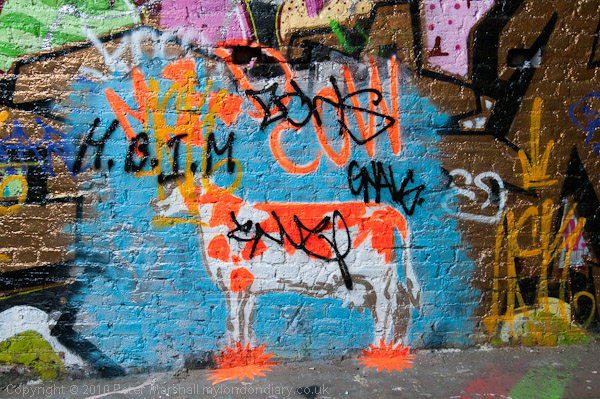
Cow and additions
more pictures
The trouble with a free for all graffiti site is that all the good
stuff here soon gets covered in rubbish. Really its more like a graffiti
war site.
more pictures
Carnival Time at Waterloo
Lower Marsh, Waterloo, London. Friday 16 Jul 2010
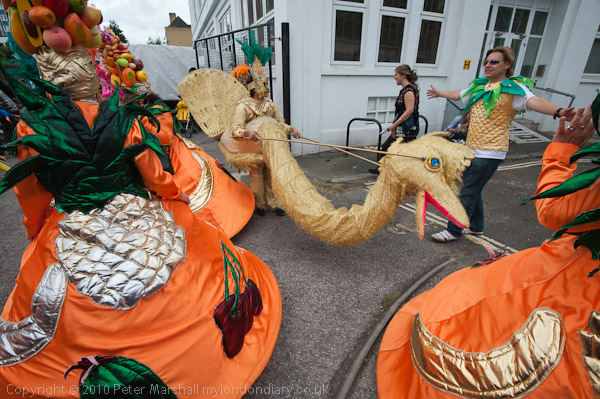
The carnival procession forms up outside Johanna
School
more pictures
Lower Marsh, alongside London's Waterloo station a few years ago was a
rather run down but vibrant street market; now it has gone considerably
up-market, with a number of specialist shops, but still keeps something
of its old character.
It's perhaps the mix of old and new in the area, along with a few
people dedicated to working to build community spirit that have led to
the annual Waterloo carnival, now in its seventh year, based around the
thriving primary school at its centre, being such a success. As well as
school children, including some from another local school, other
community groups also take part including senior citizens, toddlers and
youth groups. And one of the two samba bands came from the charity
Christian Aid whose offices are in Lower Marsh.
From Johanna School, the procession made its noisy and colourful way
along Lower Marsh before taking to the pavement along a short stretch of
the busy Westminster Bridge Road (where it would have been preferable
for police to hold up traffic for the few minutes it took to travel the
short distance - less than 200 yards - to Baylis Road. From there it
made its way to Frazier St and then through the council estate to Coral
St and Waterloo Millennium Green opposite the Old Vic.
In the gardens as a part of the festival there were stalls selling food
and also a sound system providing music, as well as the amplification
for a short address of thanks by local MP Kate Hooey who was followed by
five-year-old Leo from Johanna School singing with some backing monkeys.
After that performance the carnivalistas danced around the green for
some minutes and things got pretty chaotic. The festival continued for
the rest of the day, with more music in the gardens as well as outside
at the Cubana restuarant across the road and later at the Walrus Social
bar.
The Carnival is a community event celebrating the creative talent of
the Waterloo Community and run by Friends of Waterloo Carnival
Supporters include Waterloo Quarter BID, BFI Southbank, Walrus Social,
Cubana, Strudel, South Bank Employers’ Group, Blackfriars Settlement,
Johanna Primary School, Living Streets, Bankside Open Spaces Trust, Coin
Street Community Builders and Lambeth Council.
more pictures
Protest at Homophobic Daily Express
Lower Thames St, London. Thursday 15 July 2010
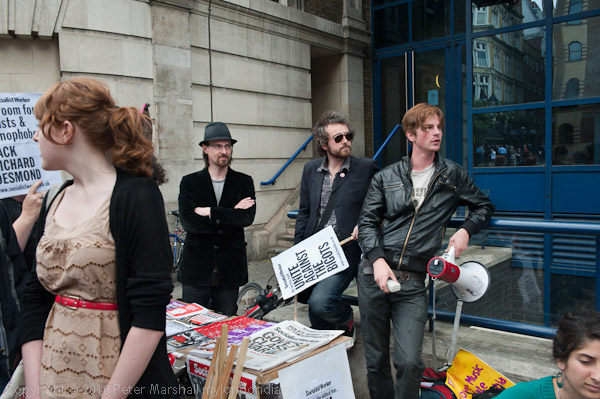
Outside the Express Building
more pictures
A protest took place outside the newspaper offices in London calling
for an apology and retraction for the homophobic views printed in The
Daily Star, Daily Express and Daily Mail about gay asylum seekers.
Following the UK supreme court decision a week ago which prevented the
deportation of two gay asylum seekers on the grounds that immigration
tribunals had to follow the 1951 UN Convention on the Status of Refugees
when making decisions over the right to asylum here, the right-wing
press had a field day with blatantly homophobic and anti-immigration
headlines and reports.
According to a letter to The Guardian signed by NUJ General Secretary
Jeremy Dear, other trade union leaders and activists and MPs Jeremy
Corbyn, John McDonnell and Caroline Lucas, "In reality, only one in 50
people who claim asylum on the basis of sexual orientation is admitted
to the UK." Currently many are sent back to their country of origin and
told to be "discreet" about their sexuality in countries where they may
face prison or even the death penalty for being gay - to lie about their
sexuality for the rest of their life. Many LGBT people seeking asylum
here are fleeing from attempted murder, serious assault or rape.
A longer statement on which the letter was based is available on the
web and many more have added there support. A Facebook group was set up
to organise a protest outside the Express offices in the city of London
on Thursday evening, to demand "an apology and retraction of the vile
views published in The Daily Star, Daily Express and Daily Mail and that
they publish the truth about the persecution which LGBT refugees and
asylum seekers face in their home countries, and about homophobia here
in Britain."
People arrived with banners and placards to attend the protest on the
street outside the offices. There were speeches from representatives of
a number of the organisations supporting the demonstration calling for
an end to racism and homophobia in the press. NUJ members working for
these papers are often appalled at the way their stories are edited to
support the racist editorial line, and headlines added which
misrepresent their reports.
The organisers also urged people to write in complaint to the papers’
editors, post comments on-line and register a complaint with the Press
Complaints Commission. The stories seem both to offend against Section
12 of the PCC's editor's code on discrimination, but also more
importantly to Section 1 (i) on Accuracy of reporting, as the judge's
comments about the freedom to go to Kylie concerts and drink
multi-coloured cocktails" were clearly used in an entirely different
context and with quite different intention.
more pictures
No To Croydon Cuts
Town Hall, Croydon, London. Monday 12 July 2010
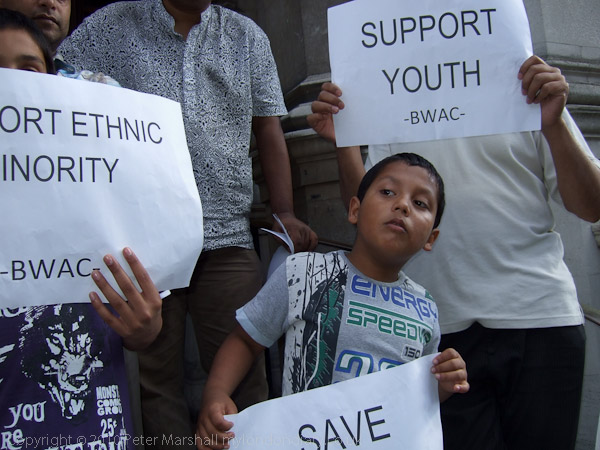 BWAC
protesters on the steps of Croydon Town Hall
BWAC
protesters on the steps of Croydon Town Hall
more pictures
Around 50 protesters were on the steps of Croydon Town Hall as I went
past on Monday evening. Inside the building the London borough's
"cabinet' were expected to ratify plans to stop funding for 41 out of
the 47 voluntary organisations that were previously supported by the
council. Roughly a third of these are expected to close because of the
withdrawal of funding, and the rest will have to seriously reduce their
services.
Under what seems ironically named the "Stronger Communities Fund"
support is being cut from £2 million to £625,000, with only 6 of the 167
applications being succesful. The cuts hit particularly hard against
groups serving the ethnic communities and vulnerable groups including
the poor and elderly.
Some of the demonstrators held placards for the Bangladesh Welfare
Association Croydon (BWAC) which a few months ago celebrated its
25th anniversary, but has now lost its £50,000 annual funding which
among other things enabled to run an advice service using volunteers to
give advice on employment, benefits and housing. Others were from the New
Addington Women's Group, whose centre which has been running for
30 years will close, ending the Women's Health Group, play schemes and
other activities.
more pictures
Thames Path: Battersea Park - Wandsworth
London. Sunday 11 July 2010
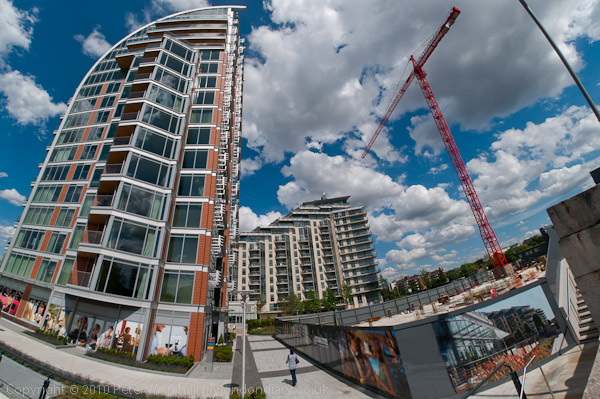
Still unfinished development next to Wandsworth
Bridge, a site occupied by 'The Land is Ours' in the 90s
more pictures
I left the French celebrations early and wandered across Battersea
Park past the fountains (they switched them off abruptly as I
photographed them) and the Buddhist temple to the Peace Pagoda where
last month I attended its 25th anniversary celebrations. Then it had
been damp with a biting cold wind, more like February than June, but
today the heat was blazing, and standing out of the shade soon
uncomfortable. But there was a little breeze and some white clouds in a
deep blue sky.
I've never been of the school that says you can't take pictures in the
middle of the day. You can make pictures in any light, just different
pictures, and digital actually makes it easier to tame the deep shadows
when necessary.
From there I walked up-river, deviating a few yards to go up Ransome's
Creek in Battersea, before returning to the river. And further down as
you approach the heliport another deviation is unavoidable, although
short of a few signposts to take you back to the river. When I first
walked along this way, rather less of the river was accessible, but what
there was certainly was more interesting. What was once an industrial
stretch of the Thames is now largely lined by often rather ugly blocks
of expensive flats, with the odd hotel thrown in. Property developers
have profited mightly from the river, and they may well be pleasant
places in which to live, but the rest of us have lost out.
Immediately past Wandsworth Bridge (a very busy road to cross, and the
way under the bridge promised for Winter 2010 will be useful) is a sand
and gravel yard still in use and of course the busy Ship pub. The path
now skirts round that and along in front of more dreary flats to the
Waste Transfer Station, which once had an overhead walkway open to the
public. It still has a sign telling you to control your children on it,
but the gate to it has long been kept locked.
I walked around and on across the Wandle, taking advantage of the
recently opened short stretch of temporary path to take a few views over
the fence of the mouth of the Wandle. I'd come around 4 miles and the
day was too hot for me to walk further, so I went up the path by the
Wandle to catch a bus at Wandsworth Plain.
more pictures
Bastille Day Comes Early in Battersea
Battersea Park, London. Sunday 11 July 2010
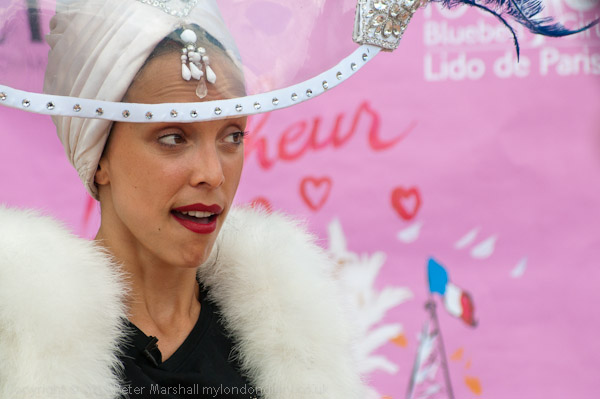 One
of the Lido dancers in Battersea Park
One
of the Lido dancers in Battersea Park
more pictures
If your dream of France is can-can dancers, petanque, touch rugby and
over-priced food and wine it was all there in Battersea Park for you on
Sunday, with a diplomat to cut the blue, white and red tape and a
wandering group of musicians who could well have been looking for a
Metro carriage. The can-can dancers were fun to watch and there was also
a performance by some improbably costumed young ladies from the Lido,
but it did all seem a caricature of the worst aspects of Paris, which I
generally manage to avoid completely when I visit there.
Many of those present were French, and it was a reminder that London
now qualifies as one of the larger French cities in the world. A small
theatre group performed around the site, but there didn't seem to me to
be a great deal happening to entertain the crowd. Perhaps things got
going after I left, but there was nothing of the popular entertainment
and dancing that I remember from the one Bastille Day I celebrated in
France, more than 40 years ago in the square by the town hall in a small
town on the edge of Paris. But perhaps nowadays it would be rather
different there too.
more pictures
No To Executions, No To Stoning
Trafalgar Square, London. Saturday 10 July 2010
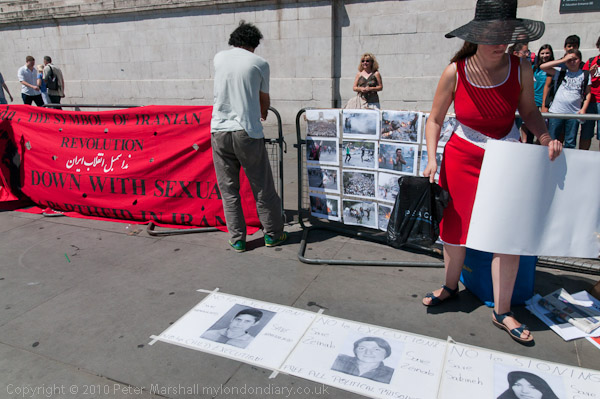
Iran Solidarity setting up the demonstration on
the North Terrace of Trafalgar Square
more pictures
I called in briefly at Trafalgar Square where Iran Solidarity
were planning to start a caravan through London against stoning
in Iran, raising awareness against the case of Sakine
Mohammadi Ashtiani, sentenced to death by stoning for alleged
adultery, as well as the other prisoners in Iran who have been executed
or are under threat of execution. The reaction around the world against
this abhorrent sentence had already caused the Iranian government to
announce she would not be stoned, and since Saturday they appear to have
said she will not be executed, at least for the time being. If her
execution goes ahead it will probably be by hanging, with a noose being
put around the neck before she is pulled up carefully to die a slow
death by strangulation.
The demonstration was just setting up when I visited it just after the
starting time and I agreed to return later. However the square had been
cleared for another event by the time I came back, and the Iran
Solidarity demonstration had been moved away. However there was another
small demonstration, raising public awareness about the June 1996 mass
killing of 1,200 political prisoners by the Libyan authorities in
Tripoli's Abu Salim prison. There is more about this on the Human
Rights Watch site.
more pictures
Somers Town Festival of Cultures
Chalton St, London. Saturday 10 July 2010
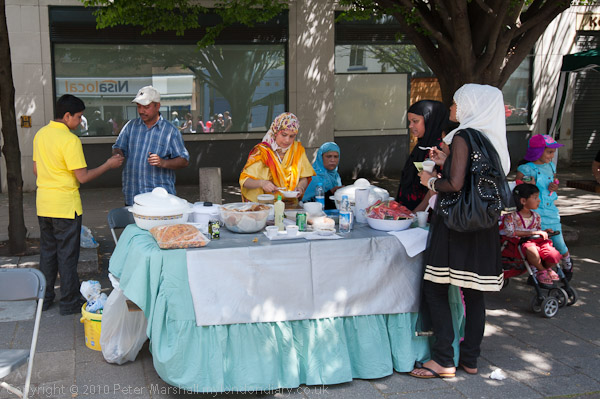
One of the many stalls selling food on Chalton St
more pictures
The LCC's Ossulston Estate, to the north of the Euston Rd between
Chalton St and Ossulton St in St Pancras was a showpiece of the late
1920s and early 1930s, based very much on the model of Vienniese social
housing, and is still visually impressive today, although some years ago
it seemed considerably more run down. A much-needed refurbishment
programme began around 2005. Architecturally important and now listed
Grade II, it offered for the time high standards of modern living
including electricity throughout and some flats had central heating, and
also represented an attempt to create a socially mixed environment, but
the architects ideas of incorporating penthouse private flats to
subsidize the social housing proved politically unacceptable. So too did
their plans to install lifts and build up to nine floors, although the
one building that was allowed seven floors was provided with a lift, but
the rest were capped at five floors. Only a part of the orginal plan was
built.
The Somers Town Festival of Cultures started in the mid-90s and
celebrates the very diverse population of the area, which also includes
another pioneering area of social housing by the St Pancras Housing
Trust as well as more modern developments by the LCC and Camden as well
as some older buildings. I've visited the festival a few times over the
years and always been impressed by the wide range of cultural activities
and community groups that take part in what is Camden's largest annual
street festival.
Among the stalls was one for the proposed UK Centre for Medical
Research and Innovation on Brill Place (behind the British Library), a
locally very contentious high rise development that will dwarf its
surroundings, at the equivalent of 13 storeys, on a site previously
earmarked for local housing. They also fear the risk of having work on
many dangerous organisms located in the centre of an area of
high-density housing. Currently the research that would take place in
the centre is carried out on a much larger site on the fringes of London
at Mill Hill, which seems to Somers Town residents to be a much more
suitable location.
There seems to be a much closer and more friendly relationship between
Somers Town and its fairly recent neighbour, the British Library, moved
here from its former home in the British Museum, who had organised their
Fiesta! event in conjuction with the Festival of Cultures. The Brill
Place site was originally intended to be a part of the library and it
will almost certainly be seen at some later date as short-sighted that
the possibility of its later expansion in this direction has not been
retained.
Somehow there seemed to be less happening at the festival this year
than in previous years, perhaps with smaller crowds and less
performances along the street. I found it hard to find things to
photograph compared to my earlier visits. But possibly I was too
occupied with events at the BL and elsewhere, and perhaps I simply went
home too early, tired by the rather oppressive heat of London.
more pictures
Fiesta! Celebrating Latin America
British Library, London. Saturday 10 July 2010
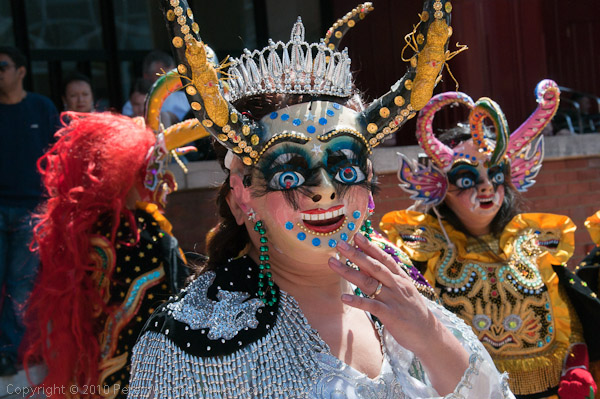
Latin American dancers in the courtyard of the British Library
The British Library joined in the celebrations of the local community
in the Somers Town Festival of Cultures by holding a day of Latin
American performances to mark 200 years since much of South America
gained independence, also marked by their special exhibition 'Viva La
Libertad!'
From the side entrance of the Library in Ossulton St you can walk
through the courtyard of one of the 1930s blocks to Chalton St where the
Somers Town Festival was taking place just a couple of minutes away, so
I was able to photograph both events, although I wasn't able to stay all
through the day.
more pictures
PCSOs Move On Deaf Mute Round World Biker
Parliament Square, London. Sunday 4 July 2010
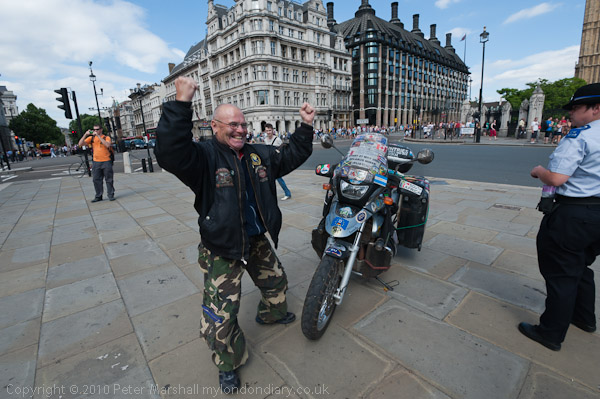
Vladimir A Yarets from Minsk in Belarus greets
PCSOs in Parliament Square
more pictures
Sixty-nine year old Vladimir A Yarets from Minsk in Belarus, a
remarkable man who had the dream of being the first deaf mute to travel
around the world on a motorbike. came to Parliament Square today.
He started his bike travels in 1967 by riding around the whole of the
USSR - and when he returned home with newspaper cuttings covering his
journey the authorities who hadn't thought he could ride a bike safely
finally relented and let him have a driving licence.
His round the world trip started on May 27 2000, and unlike some other
such travellers, Yarets beleives in doing things really thouroughly - so
in the USA he visited every state except Alaska and Hawai. He stayed in
the USA rather longer than expected when a crash which resulted in
various fractures meant he was in Peoria for almost a year. And in Cuba
he spent three months in jail for not having the correct papers.
So far he has visited more than 69 countries, covering over 300,000
kilometres on his heavily loaded and sticker-covered BMW. This wasn't
his first visit to the UK, he spent 47 days and rode 3000km here in
2000.
London didn't give him a big welcome on Sunday afternoon, with only a
handful of us watching as he drove onto the pavement below the statue of
Winston Churchill in Parliament Square, and began a balletic mime act.
It was obvious that this was something out of the ordinary, although at
the time I had no idea who this man was, the badges and printouts
plastered all over his machine and the bags and boxes attached to it
made clear what he was doing.
The two PCSOs who hurried across the road to deal with him were not
impressed, obviously unable to comprehend that he was deaf and able to
understand little of what they were telling him. They didn't seem to
have any interest at all in who he was or what he was doing, just that
he had to move that bike.
Yarets tried hard to communicate with them for several minutes, then
opened up the box behind his seat and got out a newspaper cutting about
his journeying. Unfortunately the PCSOs couldn't understand that either
(I think it was posisbly in Portuguese), and they just wanted rid of
him. One came and 'asked' me (in that police tone which means
you'd better or else) to stop taking photographs, but as when I asked
her for a reason she had no sensible answer, I continued, telling her
that we were seeing an interesting and important event that should be
recorded.
I'm glad to have met Yarets, and pleased to have shaken his hand. But
despite the evidence of Big Ben behind him, Yarets wasn't in London, but
had landed on Planet Security, a make-believe world where a remarkable
human travelling the world on a BMW is seen not as someone to be
welcomed, admired and applauded but simply as a security risk.
He loaded up his bike, unfortunately not allowed to show the people in
Parliament his simple display about his ride, something which shows how
people labelled as 'disabled' can do remarkable things, and rode just a
little sadly up Whitehall, leaving me and the others standing around
disgusted at the way he had been treated by the police.
I went to say goodbye to the Parliament Square Peace campaign - Brian
was having a little rest so I didn't disturb him, and to the others and
made my way home. Waterloo had a new service to Yorkshire to offer me,
and I photographed it but decided it would be a little out of may way.
more pictures
Chris Knight & March For England
Democracy Village, Parliament Square, London. Sunday 4 July 2010
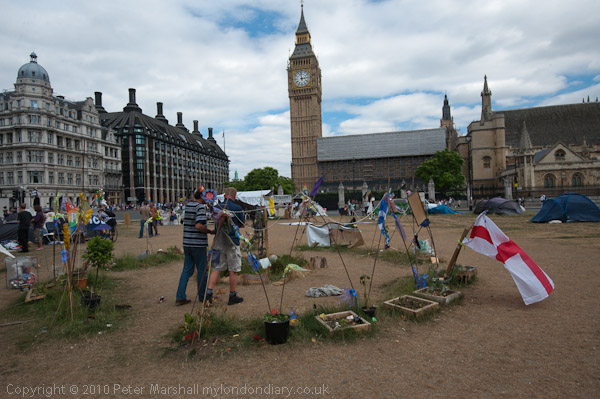
St George's Flag at the Democracy Village Peace
Garden in Parliament Square
more pictures
Several things were happening in Parliament Square that were a little
mystifying for me on Sunday afternoon. A man in a
Chubb Security
Personnel jacket was walking around making notes, one of the
campers tried to tell me there was a by-law prohibiting photography, a
foreign film group was acting a play in one corner, a couple of people
were playing air guitar in front of the '
Capitalism isn't working
banner', there was a
St George's flag in the Peace
Garden and
Chris Knight was talking with members of
March
for England.
I've been photographing March for England (MFE) since their first 'March
for the Flag' early in 2007. Although I don't share many of their
views I recognised from the start that they were voicing some of the
concerns felt by many in the largely white working-class who have been
ignored or belittled by established political parties.
From the start MFE insisted that they were not racist and that the
England that they stood for was one that embraced all races. On their
web site and Facebook pages they state in capitals: "WE ARE NOT A
RACIST GROUP NOR DO WE CONDONE ANY RACISM, NOR ARE WE AFFILIATED WITH
ANY RACIST GROUP. WE ARE ENGLISH AND PROUD - PROUD NOT RACIST."
And although it is occasionally difficult to reconcile this with some of
the shouting and chanting at the demonstrations, which have been
attended by a wider range of people, it is a view which I think the MFE
leaders hold sincerely. But clearly and very disappointingly they have
allowed the movement to be diverted by too close an alliance with other
groups and in particular the English Defence League (EDL) and
certainly their Facebook group includes at least on prominent BNP
member. It's a situation which they feel came to a head at this May's 'Patriots march'
which they helped to organise, supplying the stewarding, but which was
dominated by EDL members, and they now seem determined to separate
themselves more clearly.
On the day of the 'Patriots March' a group of MFE and EDL supporters
was apparently marching around the outside of Parliament Square and one
of the democracy campers unwisely decided to throw some old vegetables
at them. Fortunately others on the scene managed to calm the situation,
and a dialogue began between MFE supporters and some of the campers.
Today a group of MFE supporters who earlier in the day they had been in
Tavistock Square to lay wreaths in tribute to all who died in the July 7
bombings five years ago called in at the Democracy Camp to talk to Chris
Knight.
Like the campers, they are opposed to "an undemocratic government
that ignores the people", and like them are opposed to hard-line
religious extremists and fascists although in some respects the
definitions they have of these almost certainly differ. And MFE -
despite some of its racist allies - on a personal level at least seems
to welcome, as it's web site says, "everyone... Regardless of
Colour, Culture or Religion or non-Religion."
There are many on the left who see MFE simply as a slightly more
respectable front for obviously or avowedly racist organisations, and
certainly there is some evidence to support this. Many on the left
attack Professor Knight for having anything to do with them at all, and
attack others for any suggestion that they may be anything other than
die-hard racist thugs.
MFE are obviously a right-wing organisation and very much affected by
the kind of bilge pumped by much of the UK press, but it will be
interesting to see if they can continue to attract support from football
supporters and a largely politically inactive working class if, as they
say they intend, they distance themselves more clearly from the racists.
I'd rather see a left movement building a strong anti-racist presence
among the working class, but despite efforts it hasn't happened and
seems unlikely, particularly as our culture is becoming increasingly
dominated by right-wing capitalist media.
more pictures
Photographers Celebrate End of Section 44
New Scotland Yard, London. Sunday 4 July 2010
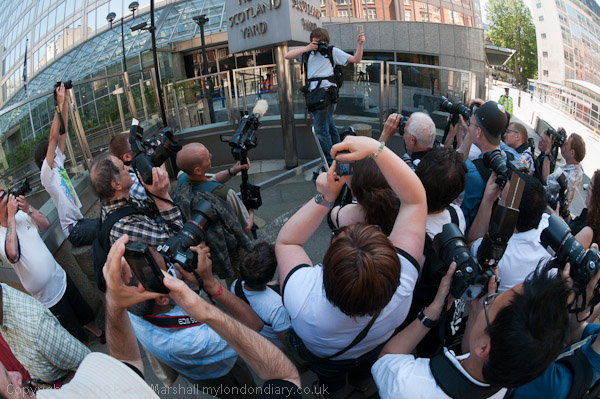
Jules Mattson, arrested a week earlier in Romford, photographs
photographers at New Scotland Yard
more pictures
More than 50 of London's leading professional photographers celebrated
last week's landmark ruling by the European Court of Human Rights
aimed at preventing police abusing powers of stop and search outside New
Scotland Yard.
The 'flashmob' demonstration, organised at the last minute by the I'm a
Photographer Not a Terrorist campaign called on the Government
to repeal section 44 of the Terrorism Act 2000 which police have been
abusing since it came into force. Four days after this demonstration,
Home Secretary Teresa May announced that they would do so.
The case was taken by photographers Kevin Gillan and Pennie Quinton,
supported by the National Union of Journalists after they were stopped
while on their way to a demonstration in east London.
The court found that it was unlawful to use section 44 to search anyone
unless there were ground for suspicion that they were engaged in
terrorism. Although the Home Office and various ministers have over the
years issued advice to police stating that they must has real and
identifiable concerns before using s44, police have continued to apply
it in a wholesale manner, particularly targetting both likely
demonstrators and journalists in areas where protests were though likely
to occur.
Photographers gathered at New Scotland Yard at 12 noon and spent an
hour on the pavement outside celebrating the court victory, and asking
that the government take the obvious step of repealing this section of
the act.
Many of those taking part have been stopped and searched under s44 on
various occasions, and all of us seem to have many tales of police
harassment - often relatively minor but at times serious. One of those
who attended was the young freelance who was last weekend arrested while
photographing a military celebration in Romford, showing remarkable
presence of mind in recording the event on his phone and also managing
to take photographs while having one arm twisted behind his back. He was
given a great welcome by all present for the way he continued to calmly
insist on his rights, despite a number of ridiculous allegations made
against him, and being pushed down some steps by the police.
One of my colleagues who attends demonstrations more regularly was
searched using s44 over 30 times in a single year. Another was stopped
and searched three times in half an hour while photographing a single
demonstration.
Press photographers carry a press card, issued by an independent scheme
approved by the police designed to limit them to genuine newsgatherers.
It has a photograph and gives their name, and the scheme also allows
police to check by a phone call using a pin-number scheme that the card
and holder are genuine.
more pictures
Pride 2010
London. Saturday 3 July 2010
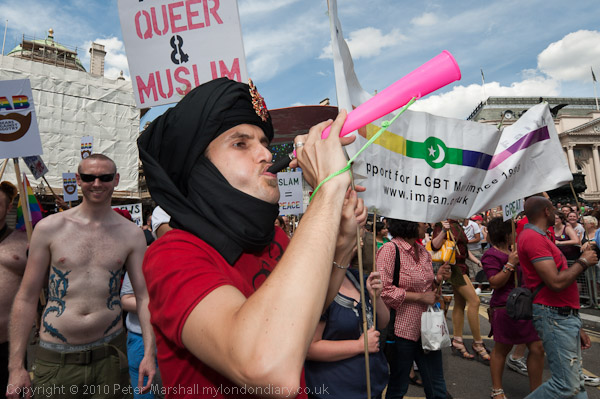
Imaan supports LGBT Muslims - and Bears Against
Bigotry back them in the march
more pictures
London's annual Gay Pride parade through London celebrated 40 years of
the Gay Liberation Front, which first brought Lesbian, Gay, Bisexual,
Transgender (LGBT) rights into the public arena.
At the head of the march was the London Gay Liberation Front (GLF)
banner, along with activists including Peter Tatchell and other original
members. In June 1970, the first Pride march took place in New York
City, and in October that year the GLF was founded and called for an end
to discrimination in law, in employment, in education and by society at
large, and an end both to feelings of guilt and shame around
homosexuality and the eradication of prejudice.
As Lisa Power says on the Pride web site, the "GLF organised the
first and the best gay demonstrations; they invented gay nuns, Gay
Days, gay communes; they made demands instead of requests; and they
improvised the first London Gay Pride."
In 1970 when gay people in the GLF marched on the streets for the first
Gay Pride it was the start of a new open and radical gay movement.
Almost all of the groups in the parade of thousands of people today owe
their existence to the GLF, and before its pioneering work the idea of
such an event was truly unthinkable.
Even into the 1990s, when I started photographing it (here is a
selection of pictures
from 1993-2002, and pictures from later years in the appropriate
months on this site), Gay Pride was very much a protest, a radical event
that many people agonized about before coming out to take part. Now it
is more of a carnival, attracting as corporate sponsors major companies
who want to promote themselves in the gay community, chasing the "pink
pound" as well as other commercial organisations providing more
targeted services.
But something of the old Pride still remains. Many of the unions that
take part have played an important role in combating discrimination in
employment, and there are still radical groups such as those calling for
asylum for LGBT refugees, Unite Against Fascism and some student groups.
more pictures
Heroes Who Fought in Spain Remembered
Jubillee Gardens, Waterloo, London. Saturday 3 July 2010
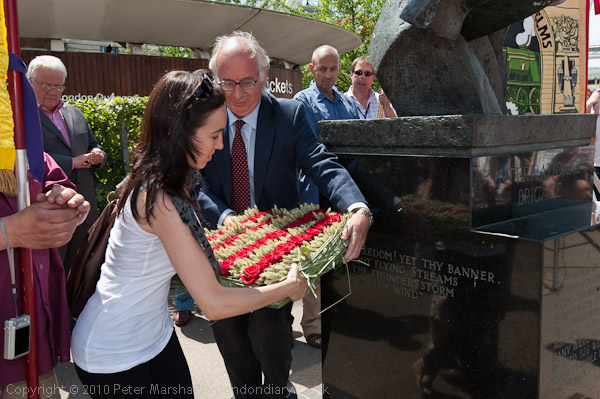
Miquel Caminal of Memorial Democràtic de Catalunya
lays a wreath at the International Brigade Memorial
more pictures
The International Brigades, in particular those British
volunteers who fought in the Spanish Civil War, were remembered at a
ceremony in London today, and flowers were laid at the memorial.
This was the first year that there were no veterans of the conflict at
the annual celebration, although seven from Britain still survive and
were awarded Spanish Passports by the Spanish Government in 2009 as a
gesture of that nation's gratitude. But more than a hundred people did
attend, including many whose parents and relatives responded to the call
to save the Spanish Republic from the Fascists.
The event opened with a song by Geoff Lawes about the eight
men from Hull who went to fight in Spain - and four died there (and
later he sang another about the greatest dirt track rider of the age who
also died there.) Spanish diplomat Ambassador Ramón Gandarias
spoke briefly, and Professor Paul Preston introduced Miquel
Caminal, the head of Memorial Democràtic de Catalunya,
a Catalonian regional government supported program to disinter, where
possible identify, and then properly rebury the war victims, many of
whom where thrown unrecorded into mass graves.
Duncan Longstaff led all of those present in the singing of 'Jarama',
and after a minute of silence to remember the dead, wreaths were laid in
their memory.
Traditionally the event concludes with the singing of the Internationale,
always a stirring sound in this company, although today I had to leave
before the end,and also missed the contributions by speakers whose
fathers had fought in Spain.
more pictures
top of page
All pictures on this section of the site are
Copyright © Peter Marshall 2010; to buy prints or for permission to
reproduce pictures or to comment on this site, or for any other
questions, contact
me.
















 BWAC
protesters on the steps of Croydon Town Hall
BWAC
protesters on the steps of Croydon Town Hall
 One
of the Lido dancers in Battersea Park
One
of the Lido dancers in Battersea Park






